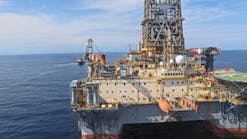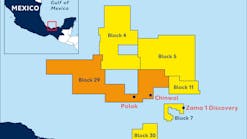Frank Hartley
Houston
New completion system
Phillips Petroleum, XTO Energy, and BP say they have lowered drilling and completion costs while boosting production from fields on the North Slope and in Cook Inlet, Alaska, using a completion system that allows re-entry into both the lateral and the main bore.
Phillips recently saved $360,000 in rig time and improved production by 280% by using this completion system in the North Slope's Greater Kuparuk West Sak formation. In Cook Inlet, XTO Energy raised oil production from an average of 150-200 b/d to 600 b/d by replacing single wells using this system. At the Milne Point Schrader Bluff S-pad expansion project, the first North Slope large-scale development to be entirely based on multilateral producers, the system increased production while allowing BP to switch to a more efficient, less costly method of artificial lift.
The system, Baker Oil Tools' Technology Advancement of Multilaterals Level 3 HOOK Hanger Multilateral Completion System, provides mechanical support for junctions that join cased and cemented main bores with screened, open-hole laterals in wells with commingled production. In Milne Point, it allows the junction and the slotted liner to be set together in one run.
The introduction of this system in January 1999 marked a significant step in the development of cost-effective, fit-for-purpose multilateral solutions because it offered the option for re-entry into both the lateral and the main bore. Prior to this development, Level 3 systems provided little functionality because a slotted liner anchored back to the main bore limited re-entry to only the lateral. Achieving re-entry into both the lateral and the main bore required moving up to a higher-complexity, higher-cost multilateral system.
This system has simplified multilateral completion operations and has been used successfully in dual and tri-lateral applications. Depending on the application, the system can be run with either of two anchoring systems. Typical installation sequence for the system is:
- The lower lateral is drilled and completed through the casing shoe
- A one-trip WindowMaster whipstock system with bottom trip anchor is run in position to drill the upper zone and set on the liner hanger
- The casing window is cut and the upper lateral is drilled to TD
- The whipstock is retrieved
- The system assembly is made up, run into the casing, and landed in the casing exit window. The system's hook engages with the lower part of the casing exit window to hang the lateral well system off the main bore casing
- The well is now ready for final completion and production.
Retrievable lateral and mainbore diverters provide future access. Both can be deployed and retrieved with either coiled tubing or jointed pipe.
Initial oil rates for the first nine years of the Milne Point field's life were 300 b/d. Since 2000, BP has completed six wells in the field using this system. To date, these multilaterals have averaged initial rates of 1,600 b/d, with one well producing 3,200 b/d in its first test.
Electric submersible pumps (ESPs) have provided artificial lift for Milne Point's Schrader Bluff formation wells since field development began. However, excessive solids production causes the ESPs to fail on average every three years, adding an average $100,000 per year ($300,000 rig cost divided by three) to each well's lifting costs. On the other hand, jet pumps can produce solids without failure and require only slickline to change. The Schrader Bluff S-pad development project currently under construction will use jet pumps as its artificial lift system. The combination of through-tubing lateral access enabled by this multilateral system and jet pumps provides assurance that if too much sand enters the slotted liners, they can be cleaned out without expensive rig workovers.
Phillips Petroleum has completed two wells with this system in the West Sak sands in the Greater Kuparuk Area. The simple installation method for this type of well has reduced the number of trips by 50% compared to a competitor system and saved over 100 hours of rig time. Esti- mated cost savings on one well were $360,000. At the same time, production increased 280% over that of a conventional single well. Whereas single wells in the field have typically produced 200 to 300 b/d, production from this system has been 600 to 800 b/d.
The recent successes with Level 3 HOOK Hanger multilaterals are raising hopes and production rates.
The system installed for XTO Energy in the Cook Inlet at 10,630 ft is the deepest to date. Previous single wells in this area had produced an average of 150 to 200 b/d. Currently, the system multilateral is producing at 600 b/d.
The combination of unstable oil prices and drilling costs typically three to five times those of drilling comparable wells in the lower 48 states or Canada present serious challenges for operators in Alaska. The recent successes with Level 3 HOOK Hanger multilaterals are raising hopes and production rates.
First remotely-operated subsea recompletion
The semisubmersible drilling vessel Deepsea Trym recently completed the first remotely-operated subsea recompletion on Statoil's I-3 H well, an oil producer on the Rimfaks satellite to the Gullfaks field in the Norwegian sector of the North Sea.
The job was enhanced by using the surface-controlled reservoir analysis and management system (Scrams) developed by Welldynamics Co., a unit of Halliburton and Shell.
Statoil has previously applied Scrams for remote operation of wells from platforms on its Gullfaks and Sleipner fields.
The system makes it possible to monitor and control well operations without expensive interventions. That contributes to improving the recovery factor without adding heavily to costs.
Evaluation of the recently completed job will help to determine whether Statoil should continue with remotely-operated well completions. The advantage of the system is that valves on the seabed can be operated from Gullfaks A. This allows the shut-off of a zone producing water and choking back production from zones that primarily produce gas in a reservoir containing oil, water, and gas. The I-3 H which lies in 135 m of water, was cleaned and brought back on stream, but has now been temporarily shut down because of a turnaround.
Statoil has 140 subsea wells, making it the world's second-largest operator of such installations after Brazil's Petrobras. Statoil's total is expected to be about 200 by the end of the year.
Sand control completion record
She has completed a world record sand control completion in the East Anstey portion of its Na Kika development in the Gulf of Mexico. The frac pack treatment was developed and implemented by Halliburton's Stim Star III service vessel in 6,780 ft water depth.
The East Anstey Well, located in 6,780 ft of water, was treated at a maximum rate of 50 barrels per minute (bpm) to place 239,000 lb of proppant. The rate of 50 bpm is higher than a previous frac pack record of 45 bpm achieved earlier this year.






